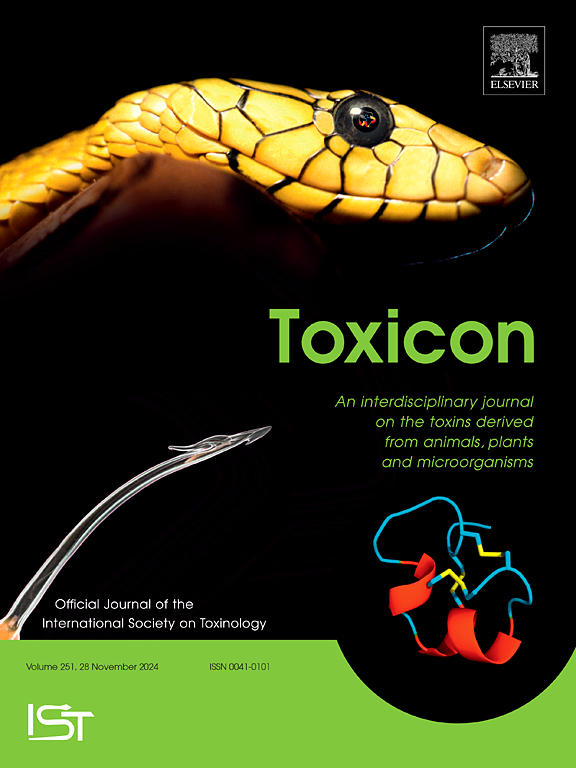墨西哥一种与医学有关的蝎种——雪蝎(Centruroides baergi Hoffmann, 1932)毒液成分的差异和形态计量学
IF 2.6
4区 医学
Q2 PHARMACOLOGY & PHARMACY
引用次数: 0
摘要
baergi是一种分布在墨西哥巴尔萨斯盆地生物地理省的蝎子。卫生官员报告说,生活在这种蝎子活动范围西侧的人群出现了急性中毒,但东部地区没有。这种毒性的差异表明可能存在两个不同的物种。我们使用了两种不同的方法,包括毒液分析和来自两个地区的形态测量标本,来验证我们的假设。我们进行了色谱、电泳和质谱分析,以确定与中毒有关的已知β-毒素。最显著的发现是东部人群中不存在Cb3 β-毒素。因此,东部人群的LD50低于西部人群。我们用参数和非参数统计分析了线性和比例身体测量来测试物种极限。这些分析表明,所有假定的贝尔氏菌种群都非常相似,表明它们可能代表一个单一物种。出乎意料的是,在研究区域的中心,Suchixtlahuaca的种群,先前被确定为C. baergi,显示出显著的形态和毒液组成差异。我们提供的经验证据表明,在第98子午线附近,高毒性肽的突然变化限制了墨西哥东部的贝氏Centruroides baergi种群。本文章由计算机程序翻译,如有差异,请以英文原文为准。
Disparity among venom components, and morphometrics in Centruroides baergi Hoffmann, 1932, a medically relevant scorpion species from Mexico
Centruroides baergi is a scorpion species distributed in the biogeographical province of the Balsas Basin in Mexico. Health officials have reported acute envenomation in human populations living on the western side of this scorpion's range, but none in the eastern region. This disparity in toxicity suggested that there may be two distinct species. We used two different approaches, including venom analysis and morphometric specimens from both regions, to test our hypothesis. We performed chromatographic, electrophoretic, and mass spectrometry analysis to identify the known β-toxins involved in the intoxication. The most remarkable finding was the absence of Cb3 β-toxin in the eastern population. Consequently, the LD50 of the eastern population was lower than that of the western population. We analyzed linear and ratio body measurements with parametric and nonparametric statistics to test species limits. These analyses indicated that all putative populations of C. baergi are significantly similar, suggesting that they may represent a single species. Unexpectedly, the population of scorpions in the center of the study area, Suchixtlahuaca, previously identified as C. baergi, showed significant morphological and venom composition differences. We provided empirical evidence of an abrupt change of highly toxic peptides around the 98th meridian that limits populations of Centruroides baergi to the east of Mexico.
求助全文
通过发布文献求助,成功后即可免费获取论文全文。
去求助
来源期刊

Toxicon
医学-毒理学
CiteScore
4.80
自引率
10.70%
发文量
358
审稿时长
68 days
期刊介绍:
Toxicon has an open access mirror Toxicon: X, sharing the same aims and scope, editorial team, submission system and rigorous peer review. An introductory offer Toxicon: X - full waiver of the Open Access fee.
Toxicon''s "aims and scope" are to publish:
-articles containing the results of original research on problems related to toxins derived from animals, plants and microorganisms
-papers on novel findings related to the chemical, pharmacological, toxicological, and immunological properties of natural toxins
-molecular biological studies of toxins and other genes from poisonous and venomous organisms that advance understanding of the role or function of toxins
-clinical observations on poisoning and envenoming where a new therapeutic principle has been proposed or a decidedly superior clinical result has been obtained.
-material on the use of toxins as tools in studying biological processes and material on subjects related to venom and antivenom problems.
-articles on the translational application of toxins, for example as drugs and insecticides
-epidemiological studies on envenoming or poisoning, so long as they highlight a previously unrecognised medical problem or provide insight into the prevention or medical treatment of envenoming or poisoning. Retrospective surveys of hospital records, especially those lacking species identification, will not be considered for publication. Properly designed prospective community-based surveys are strongly encouraged.
-articles describing well-known activities of venoms, such as antibacterial, anticancer, and analgesic activities of arachnid venoms, without any attempt to define the mechanism of action or purify the active component, will not be considered for publication in Toxicon.
-review articles on problems related to toxinology.
To encourage the exchange of ideas, sections of the journal may be devoted to Short Communications, Letters to the Editor and activities of the affiliated societies.
 求助内容:
求助内容: 应助结果提醒方式:
应助结果提醒方式:


